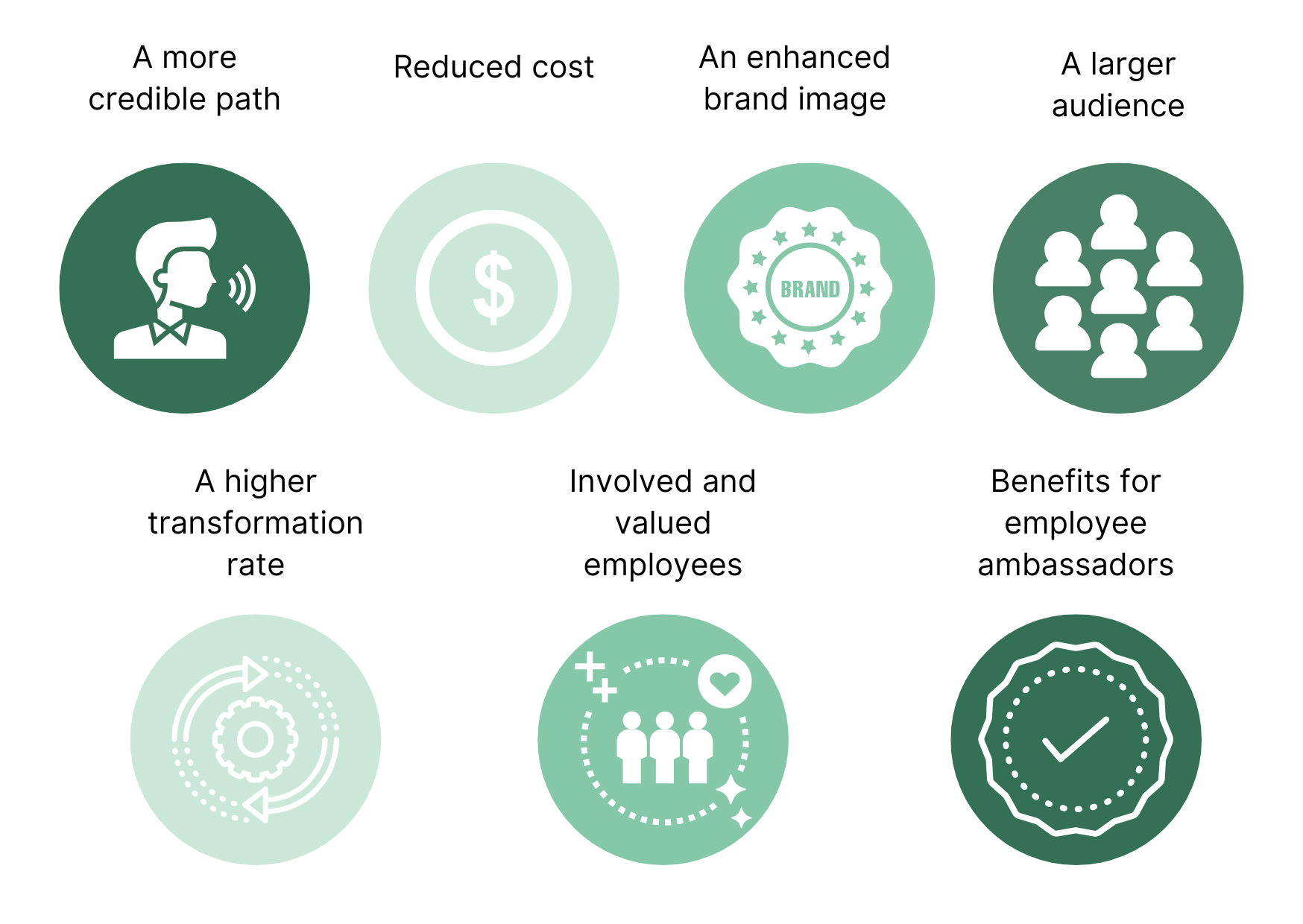
7 Steps to Set Up Your Employee Advocacy Program
Last update: 27 April 2023 at 11:17 am
Employee advocacy or employee ambassadors is a communication strategy that encourages your employees to talk about you on social networks and increase your visibility as a result.
Currently, it is difficult to get an audience for a corporate speech. Make your brand known thanks to the playful and dynamic speeches of your employees through social networks to develop your notoriety and generate leads.
According to the Edelman barometer, consumers trust employees more than the company’s hierarchy. Thus, employee advocacy is one of the most effective marketing strategies on the market to increase your visibility through social media
Definition of Employee Advocacy
Employee advocacy is a strategy that allows you to turn employees into ambassadors of your brand. To do so, they speak out on social networks about your company, your brand, your products, and/or services.

This marketing strategy is usually part of a B2B approach, but it is also applicable in B2C.
Your employees intervene on social networks and various employee advocacy platforms to promote your company.
To do so, they can talk about both their professional and personal lives, through which they make the link with the company. Employee advocacy is a revolutionary method that was born with the advent of social networks.
For example, the brand Reebok advocates a healthy lifestyle and has highlighted this commitment through its employees. Using the #fitasscompany, employees were able to share their moments of life dedicated to sports.

Previously, companies used to express themselves through their leaders. But their word could not always be considered objectively. Companies are slowly losing their voice. Fortunately, it has become possible to give voice to other more neutral members of the company through social media.
The publishing and engagement platforms confirm this trend, another place where employee ambassadors can express themselves to promote the company, its products, and services.
Need |
Discover the most relevant agencies for your project based on your own specific requirements.
Find an agency!What Are the Advantages of Employee Advocacy in Companies?
Making your employees ambassadors of your brand brings many benefits to your company.

A more credible voice
Consumers trust a company’s employees more than its managers or even less than outsiders.
They have a better knowledge of the brand and its products than people outside the company. And they can give objective opinions about management.
Simply choose leaders within your organization who can speak to the value of your brand.
Low cost
Communication is expensive these days if you have to use influencers or hire a community manager on social networks.
Employee advocacy gives you the opportunity to massively develop your brand without spending a fortune. You will have enough margin to get more profit on your products.
Enhanced brand image
Employee advocacy is a program that builds credibility. Giving a voice to your employees means trusting them and appreciating them at their true value.
At the same time, it reflects an engaging and inclusive corporate culture.
A wider audience
Each of your employees has their own type of social media contacts. The employee advocacy program allows you to reach more targets.
A higher conversion rate
As you reach more varied and qualified targets, your conversion rate will also naturally increase. By talking about you on social networks, your employees will attract new prospects that you can easily convert.
Involved and valued employees
Give your employees the freedom to express themselves instead of imposing their speech. They will feel valued since they can speak on your behalf as if they were the ones in charge.
At the same time, they can demonstrate their expertise to the audience. You are sure that they will share high-value-added content. Do not impose any way of communicating, the best is that they communicate freely in a relaxed and playful way.
Benefits for employee ambassadors
To motivate your employees in the framework of an employee advocacy program, you can offer benefits in kinds such as gift certificates or vouchers.
Social recognition is also a good idea by nominating the best employee of the month. Your employees will be more than motivated to represent your company and become its spokesperson.
How to Set up an Employee Advocacy Strategy in 7 Steps?
To develop an employee ambassador program, you need to follow a few specific steps.
In any case, in order for the ambassador to speak on behalf of your brand with relevance, you need to train them on brand branding and personal branding.
Take care of your corporate culture
Quality of work life is more motivating than compensation for many employees, especially millennials.
As such, it’s imperative to improve the work environment and atmosphere at work to foster employee engagement. Build a real bond with your employees by building on mutual trust. To do this:
- Improve the structure for a more innovative setting.
- Show your appreciation for your employees to make them feel valued.
- Carry out responsible actions such as charitable or ecological works.
- Become a leader in your industry by empowering each of your employees to be a leader in what they do.
- Improve internal communication through innovative methods like social networking.
Encourage Employee Engagement
For employee advocacy to work, you need to get your employees on board. They need to talk about your company and recommend your brand on their own initiative. To do this, there are several methods to apply.
Be grateful
Show your appreciation to the most deserving employees with programs like “employee of the month”. You’ll see that your employees’ engagement rate will increase.
At the same time, show your enthusiasm for the program to get your employees’ attention and demonstrate the importance of the goals to be achieved.
Communicate the benefits to them
Ask instead of demanding testimonials or communications on behalf of your company.
Offer benefits to be earned to motivate them. You can ask them what kind of gifts they will want to receive to get them more involved.
Make referrals easy
Make the process simple and fun. Suggest interesting topics that can be discussed as part of this marketing strategy.
Create your own hashtags to promote by offering everyone the possibility to choose the topic to be covered. Diversify the form of content that can be shared: text, photos, videos, etc.
Set the Objectives for Your Employee Advocacy Program
It is true that the initiative must come from your employees. They have to become ambassadors by their own free will. To do this, they may already be sharing information and news about your company on social networks.
But for an employee advocacy program to be successful, you need to establish a well-defined process. First, you need to set goals for each participant.

In order to evaluate the success of this marketing strategy, you must establish specific actions. If your goal is to increase your visibility, encourage employees to talk about the brand around them.
If you want to promote a specific product, create a card that they can share directly. You can also choose leaders among your employees to talk about you on dedicated platforms.
These well-defined actions all increase the organic reach of your employee advocacy program. You’ll get more traffic to your site, business, or store from social media.
Establish Guidelines to Follow on Social Networks
Building employee advocacy is a very effective marketing strategy to increase your audience on social networks. However, if everyone does it in their own way, it is difficult to evaluate the result.
Create a certain uniqueness in your strategy by defining:
- The topics to address,
- The language register to adopt,
- The frequency of publication,
- Etc.
Write a guideline to guarantee the consistency of your communication both on the personal accounts of your employees and on social media platforms.
Be careful, however, these guidelines should not be too restrictive but only serve as a guide to facilitate the creation of content.
Adopt Good Practices on Social Networks
You need to inform your engaged employees about the best practices to follow on social media. To do so, you can organize free trainings or courses to help them create content easily.
You can also create content (such as company news) that can be shared regularly. Then, all the brand ambassadors have to do is share them. They can also take inspiration from this content and create personalized content before posting them on social media.
Designate Successful Employee Advocacy Program Managers
The employee advocacy marketing strategy creates many responsibilities for the business owner.
You must fulfill several functions:
- Define the missions,
- Share the responsibilities,
- Provide incentives,
- and so on.
To save yourself from these recurring tasks and instead focus on building your brand, designate one employee to lead the advocacy program.
Create a cascading process with one person leading the entire team. This person will be the main point of contact for all ambassadors to give direction and receive feedback. He or she will also have the important task of keeping the entire team motivated.
The implementation of the employee ambassador program is a long-term process. Content must be shared regularly to maintain the audience and in this case, the visibility of the brand. It is also important to create a certain dynamism and not to fall into monotony to make your communication always attractive.
Measure the Success of the Program
The last step is to closely monitor the performance indicators to know if your employee strategy has worked. If so, this step allows you to identify the obstacles to improving the process.
It all depends on the objective you set at the beginning if you want to generate more leads, get more traffic on your site or increase your share of voice.
How to measure its effectiveness?
To evaluate the return on investment or ROI of your employee advocacy programs, you can establish a few parameters for analysis:
- The different contributors: the employees participating in the program who shared content on social networks. The social networks used and the ambassadors who had the highest engagement rate.
- Organic reach of shares: the content shared by each employee was seen by how many people?
- Audience engagement: what is the rate of people who clicked on your links? What is the interaction rate if visitors left comments, clicked on links, and re-shared the content?
- Traffic: what is the traffic generated per ambassador, per content, and per network? You can use tools like Google Analytics to do this.
- Conversion and bounce rate: did the visitor convert to a lead? Did they fill out a contact form, purchase a product or order a service?
Ready to create a successful employee advocacy program? Motivate your employees to become your ambassadors. Designate a leader to head the team. Provide the most relevant topics to talk about around your brand and diversify the format to share.





